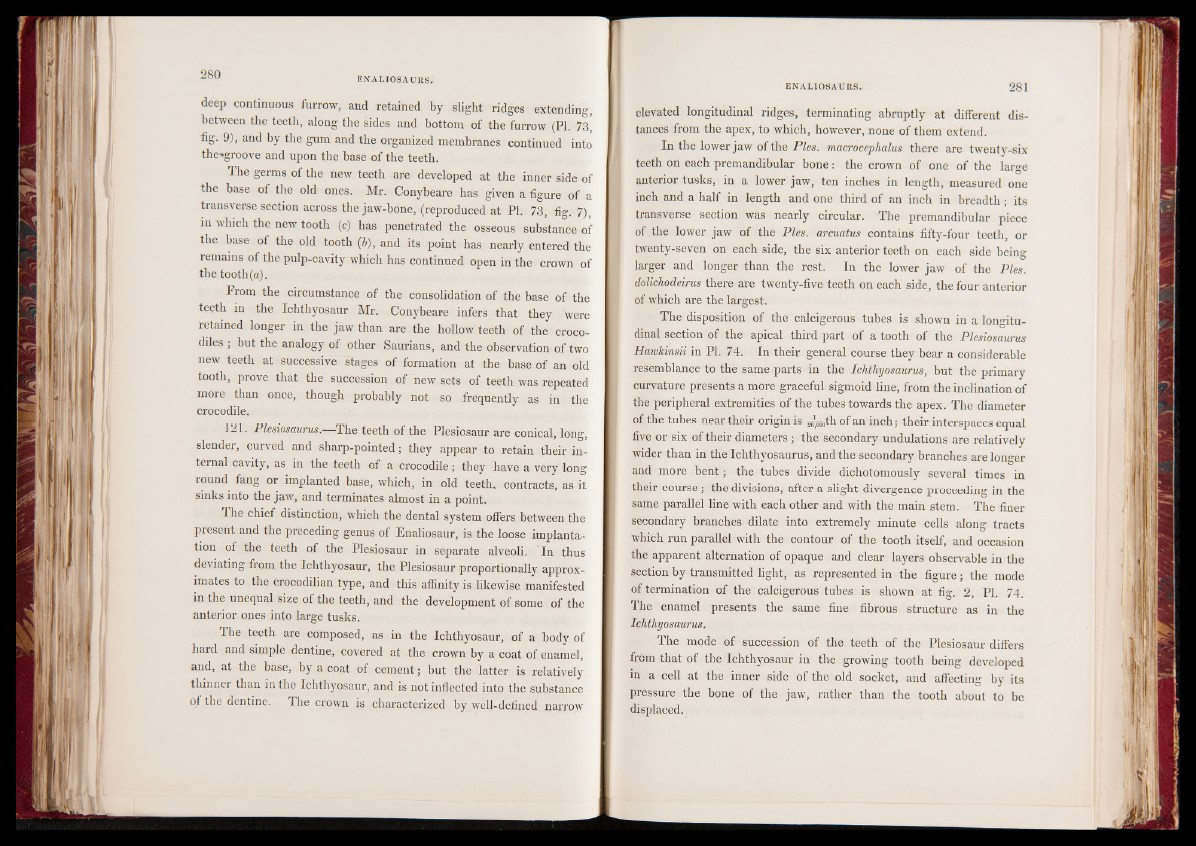
ENALIOSAURS.
deep continuous furrow, and retained by slight ridges extending,
between the teeth, along the sides and bottom of the furrow (PI. 73*
fig. 9), and by the gum and the organized membranes continued into
the-groove and upon the base of the teeth.
The germs of the new teeth are developed at the inner side of
the base of the old ones. Mr. Conybeare has given a figure of a
transverse section across the jaw-bone, (reproduced at PI. 73, fig. 7)
in which the new tooth (c) has penetrated the osseous substance of
the base of the old tooth (b), and its point has nearly entered the
remains of the pulp-cavity which has continued open in the crown of
the tooth (a).
From the circumstance of the consolidation of the base of the
teeth in the Ichthyosaur Mr. Conybeare infers that they were
retained longer in the jaw than are the hollow teeth of the crocodiles
; but the analogy of other Saurians, and the observation of two
new teeth at successive stages of formation at the base of an old
tooth, prove that the succession of new sets of teeth was repeated
more than once, though probably not so frequently as in the
crocodile.
1 2 1 . Plesiosaurus.—The teeth of the Plesiosaur are conical, long,
slender, curved and sharp-pointed; they appear to retain their internal
cavity, as in the teeth of a crocodile; they have a very long
round fang or implanted base, which, in old teeth, contracts, as it
sinks into the jaw, and terminates almost in a point.
The chief distinction, which the dental system offers between the
present and the preceding genus of Enaliosaur, is the loose implantation
of the teeth of the Plesiosaur in separate alveoli. 'In thus
deviating from the Ichthyosaur, the Plesiosaur proportionally approximates
to the crocodilian type, and this affinity is likewise manifested
in the unequal size of the teeth, and the development of some of the
anterior ones into large tusks.
The teeth are composed, as in the Ichthyosaur, of a body of
hard and simple dentine, covered at the crown by a coat of enamel,
and, at the base, by a coat of cement; but the latter is relatively
thinner than in the Ichthyosaur, and is not inflected into the substance
of the dentine. The crown is characterized by well-defined narrow
elevated longitudinal ridges, terminating abruptly at different distances
from the apex, to which, however, none of them extend.
In the lower jaw of the Pies, macrocephalus there are twenty-six
teeth on each premandibular bone: the crown of one of the large
anterior tusks, in a lower jaw, ten inches in length, measured one
inch and a half in length and one third of an inch in breadth; its
transverse section was nearly circular. The premandibular piece
of . the lower jaw of the Pies, arcuatus contains fifty-four teeth, or
twenty-seven on each side, the six anterior teeth on each side being
larger and longer than the rest. In the lower jaw of the Pies,
dolichodeirus there are twenty-five teeth on each side, the four anterior
of which are the largest.
The disposition of the calcigerous tubes is shown in a longitudinal
section of the apical third part of a tooth of the Plesiosaurus
Hawkinsii in PL 74. In their general course they bear a considerable
resemblance to the same parts in the Ichthyosaurus,. but the primary
curvature presents a more graceful sigmoid line,.from the inclination of
the peripheral extremities of the tubes towards the apex. The diameter
of the tubes near their origin is -^„th of an inch; their interspaces equal
five or six of their diameters ; the secondary undulations are relatively
wider than in the Ichthyosaurus, and the secondary branches are longer
and more bent; the tubes divide dichotomously several times in
their course ; the divisions, after a slight divergence proceeding in the
same parallel line with each other and with the main stem. The finer
secondary branches dilate into extremely minute cells along tracts
which run parallel with the contour of the tooth itself, and occasion
the apparent alternation of opaque and clear layers observable in the
section by transmitted light, as represented in the figure; the mode
of termination of the calcigerous tubes is shown at fig. 2, PI. 74.
The enamel presents the same fine fibrous structure as in the
Ichthyosaurus.
The mode of succession of the teeth of the Plesiosaur differs
from that of the Ichthyosaur in the growing tooth being developed
in a cell at the inner side of the old socket, and affecting by its
pressure the bone of the jaw, rather than the tooth about to be
displaced.